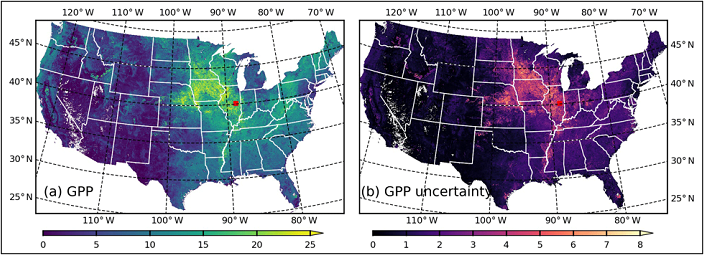The ORNL DAAC recently released this dataset from the Carbon Monitoring Systems (CMS) project by Jiang, C., et al., (2021):
MODIS-based GPP, PAR, fC4, and SANIRv estimates from SLOPE for CONUS, 2000-2019
This dataset contains estimated gross primary productivity (GPP), photosynthetically active radiation (PAR), soil adjusted near infrared reflectance of vegetation (SANIRv), the fraction of C4 crops in vegetation (fC4), and their uncertainties for the conterminous United States (CONUS) from 2000 to 2019. The daily estimates are SatelLite Only Photosynthesis Estimation (SLOPE) products at 250-m resolution. There are three distinct features of the GPP estimation algorithm: (1) SLOPE couples machine learning models with MODIS atmosphere and land products to accurately estimate PAR, (2) SLOPE couples gap-filling and filtering algorithms with surface reflectance acquired by both Terra and Aqua MODIS satellites to derive a soil-adjusted NIRv (SANIRv) dataset, and (3) SLOPE couples a temporal pattern recognition approach with a long-term Crop Data Layer (CDL) product to predict dynamic C4 crop fraction. The SLOPE product is advanced in its spatial resolution (250m), temporal resolution (daily), and quantitative uncertainty
The NASA CMS program is designed to make significant contributions in characterizing, quantifying, understanding, and predicting the evolution of global carbon sources and sinks through improved monitoring of carbon stocks and fluxes. The System uses NASA satellite observations and modeling/analysis capabilities to establish the accuracy, quantitative uncertainties, and utility of products for supporting national and international policy, regulatory, and management activities. CMS data products are designed to inform near-term policy development and planning.
Additional data from Carbon Monitoring System (CMS) project and other relevant links can be found on the ORNL DAAC's CMS Project Page.
Citation: Jiang, C., and K. Guan. 2020. MODIS-based GPP, PAR, fC4, and SANIRv estimates from SLOPE for CONUS, 2000-2019. ORNL DAAC, Oak Ridge, Tennessee, USA. https://doi.org/10.3334/ORNLDAAC/1786

